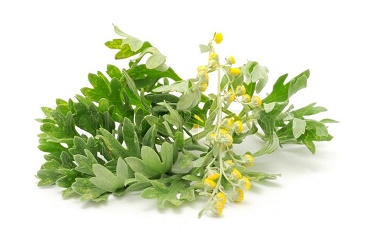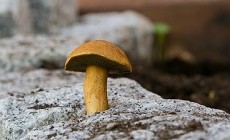
This owes it all to the finding of artemisinin – a malaria drug that has saved millions of lives worldwide especially in developing countries. And the fame of wormwood consummated in 2011 when Tu Youyou, the pharmacologist who first discovered artemisinin in wormwood, won America’s respected Lasker Award for that reason. Therefore, Chinese media reports said that this could be the best proof for growing skepticism about the efficacy of traditional Chinese medicine. More than that, what is wormwood used for is more than just the malaria treatment.
What is wormwood?
Medicinally it mainly refers to the dried aerial part of Artemisia annua L. As a common type of wormwood in the family Compositae, Artemisia annua is native to temperate Asia and later introduced to every corner of the globe. Other names of this plant include annual wormwood, Herba Artemmisiae, sweet Annie, sweet wormwood, sweet sagewort, and so on. In China it is distributed in most areas of the country. It is harvested in summer and autumn when the flowers are going to bloom. After that, it needs to remove the old stems. And it is used fresh or dried in the shade. By the way, Artemisia japonica Thunb., another plant in the same genus, is also used as Qing Hao in some regions of China since it has similar efficacy. However, it can’t treat malaria. So, it is necessary to tell them apart medicinally.
Wormwood herb is an annual herb, 40 to 150cm in height. The whole plant is with a strong odor of volatile oil. Erect stems are with vertical stripes, smooth, hairless, and with multiple branches. Basal wormwood leaves lay flat on the ground and wither when blooming; alternate stem leaves turn green when young and brown when old. Leaf blade is usually tripinnatisect, and with short lobes and tiny powdered pubescence; rachis is with narrow wings on both sides; upper leaves taper downward and become a strip. Small capitulum is spherical, about 2mm in diameter, and with small short soft stems; small involucre is hemispheric; all flowers are tubular and yellow, female flowers outside and bisexual flowers in the center. Achenes are elliptical. Flowering time is from August to October and fruiting time is from October to November. Main habitats are wilderness, hillsides, roadsides, and riverbanks.
Wormwood herb benefits
In Vol.3, Section 16 of Zhou Hou Bei Ji Fang (Emergency Prescriptions kept in one’s Sleeve), Ge Hong, the famous Taoist leader during the Eastern Jin Dynasty, ever briefly mentioned how to use wormwood plant to treat all cold or heat-induced malaria: “gather a handful of fresh wormwood plants, soak them with 2 liters of water, extract the juice by twisting, and drink it all.” This is the earliest record about using Artemisia herb to cure malaria, not only in the medical history of Chinese but also the world.
And this brief comment turns out to be a great inspiration to the modern pharmacological studies. In 1971 researchers of Chinese Medicine Research Institute did find valuable clue when they red this text. And based on it they finally got on the right track and discovered the antimalarial drug artemisinin.
As the main active ingredient of Artemisia annua, artemisinin is poorly soluble in water and will decompose and lose efficacy above 60 degrees Celsius. In 1972 the effective monomer of artemisinin was successfully extracted with an organic solvent at low temperature. Artemisinin monomer is a highly effective, fast-acting antimalarial that is with low toxicity. This is completely different from drugs in chloroquine structure. And the rest is history.
In the field of basic biomedical research, the value and benefits of many important discoveries are not immediate. But a few of them are exceptional. The birth of them plays an immediate role on improving human health. And the discovery of antimalarial artemisinin, conducted by Tu Youyou and her colleagues, is one great example. Since the late 1990s, artemisinin, acting as a first-line drug for malaria, has saved countless lives, among which most were children living in the poorest regions of the world.
Modern pharmacological actions of wormwood herbs
1. The dilute ethanol extract and neutral part of its ether extract have significant antimalarial action;
2. Artemisinin and its derivatives prevent animal schistosomes;
3. Artemisinin, artemether, and artesunate can promote the health of immune system in body’s cells;
4. Artemisinin can slow down the heart rate, inhibit myocardial contractility, reduce coronary blood flow and lower blood pressure;
5. Artemisia annua can kill a variety of bacteria and viruses;
6. It has better antipyretic and analgesic effect. In addition, it has a synergistic effect with honeysuckle and the antipyretic effect is rapid and lasting;
7. Artemether has radiation protection;
8. Artemisinin has significant effect on experimental silicosis;
9. Studies have shown that in vitro artesunate has significant cytotoxic effect on human hepatoma cells. And oral administration of artesunate showed that in vivo it had anti-cancer effects in mice’s liver cancer cells. In addition, it has synergistic anticancer effects with 5-fluorouracil;
10. The results of special toxicity test on wormwood showed that artemisinin may have genetic toxicity and artesunate has significant embryotoxicity, which can affect fetal bone growth and intrauterine growth retardation if administrated during early pregnancy.
Sample wormwoods recipes on herbal remedies
The Encyclopedia of Chinese Materia Medica says that wormwood is bitter and slightly acrid in flavor and cold in nature. It goes to meridian s of liver and gallbladder. Primary functions are clearing heat, relieving summer-heat, eliminating hectic fever, and preventing malaria. Basic wormwood herb uses and indications include summer-heat, summer-heat and damp, damp-warm syndrome, fever due to yin deficiency, malaria, and jaundice. Recommended wormwood dosage is from 6 to 15 grams in decoction. When used in curing malaria, 20 to 40 grams of dried wormwood or doubling the amount of fresh wormwood is needed. But you should be careful not to cook them too long or the active ingredients would get spoiled. What’s more, it can be used in the forms of wormwood supplement, tea, extract, capsules, tincture, absinthe (liquor), powder, pills, and more.
1. Qing Hao Bie Jia Tang from Wen Bing Tiao Bian (Detailed Analysis of Warm Diseases). It is formulated with Bie Jia (Soft Turtle Shell), Mu Dan Pi (Tree Peony), Zhi Mu (Anemarrhena Rhizome), Sheng Di Huang (Rehmannia), etc. to treat syndrome of lingering heat in later period of warm diseases or lingering low-grade fever after febrile disease.
2. Qing Gu San from Zheng Zhi Zhun Sheng (The Level-line of Patterns and Treatment). It is combined with Yin Chai Hu (Stellaria), Hu Huang Lian (Picrorhiza Kurroa), Anemarrhena Rhizome, Soft Turtle Shell, etc. to cure deficiency type fever, hectic fever due to yin deficiency, consumptive fever, hot flashes, night sweats, dysphoria in chest, palms, and soles, and red tongue with little coating.
3. Qing Liang Di Shu Tang from Shi Bing Lun (Treatise on Seasonal Diseases). It is matched with Lian Qiao (Forsythia), Hua Shi (Talcum Powder), Xi Gua Cui Yi (Pericarpium Citrulli Vulgaris), etc. to heal exogenous summer-heat, dizziness, headache, fever, and thirst.
4. Hao Qin Qing Dan Tang from Tong Su Shang Han Lun (Popularized Treatise on Cold Damage). It is coupled with Huang Qin (Scutellaria Baicalensis), Talcum Powder, Ban Xia (Pinellia), etc. to treat damp-heat stagnated in Shaoyang Triple Burner, disorder of qi movement, alternative chill and fever resembling malaria, feeling of stuffiness in chest, and feeling like vomiting.
5. Qing Hao Wan from Sheng Ji Zong Lu (Complete Record of Holy Benevolence). It is equipped with Ren Shen (Ginseng) and Mai Men Dong (Mondo Grass) to cure consumptive disease, night sweats, dysphoria with smothery sensation, and dry mouth.











